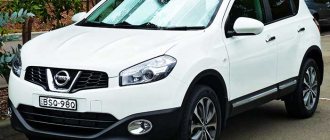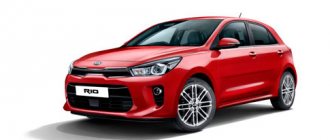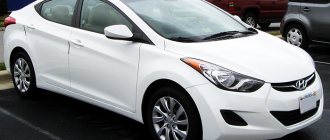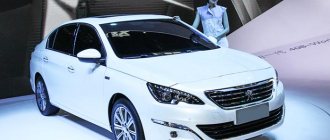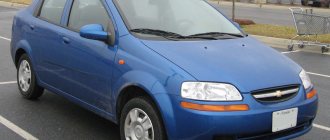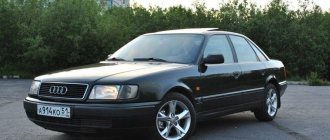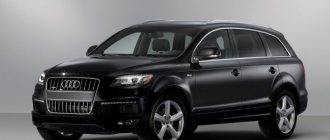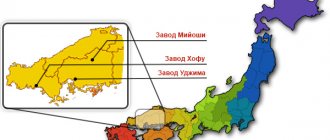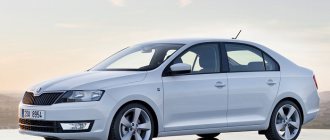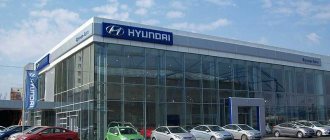Story
was born in 1909, ahead of its main competitors. The headquarters of the concern is located in Ingolstadt.
Cars currently in production were originally produced under the Auto Union brand. The company took off after World War II thanks to the purchase of all shares. In 1964, Auto Union became a subsidiary. Thanks to their joint activities, the concern produced many iconic cars, such as the Audi 100 (popularly nicknamed the cigarette), Audi 80, Audi Q7 and many others.
The company is still not losing ground in the automotive market, producing more and more premium cars, an example of which is the new Audi A8.
Some exterior features
In general, the Audi Q5 does not stand out in any way from the general background of modern crossovers, except that it can be easily recognized by its signature wide radiator grille and ring-shaped emblems at the front and rear.
“Ku Fifth”, like many similar cars, is endowed with a neat rear spoiler, a “shark fin” antenna on the roof, has embossed side doors, large wheel arches that practically follow the shape of the wheel, and large “burdock” exterior mirrors on strong legs.
This model does not have composite taillights; the optics are present only on the tailgate, without extending onto the fenders.
Other characteristic exterior details of the Audi Q5 include:
- somewhat unusual door mechanism - to open the door, the handle must be pulled up;
- the presence of long red reflectors on the sides of the rear bumper;
- felt fender liners - unlike plastic lockers, they contribute to a more effective reduction in noise levels in the cabin.
An original design solution is the design of fake exhaust pipe tips in the form of a strip almost across the entire width of the car, and this decorative element is made with a chrome edging.
The German automaker offers the Q5 crossover in a variety of exterior colors, but it's interesting to note that the car doesn't look as attractive in light colors as it does in dark paint.
Audi cars: localization of assembly plants and production features
The phrase “German quality” when choosing any product on the market or in a store has always become a special argument in favor of the profitability of the purchase, mainly when it characterized expensive products, in particular, equipment and transport. For every car owner, for many years now, a car with the coveted four rings under the Audi brand has been an undeniable example of reliability and quality. Most drivers and potential car buyers are sure: the country of manufacture of Audi and the place of assembly are absolutely identical concepts, which is initially an incorrect statement. In this article we will tell you where Audi is assembled, focusing on the model range and popular examples from the manufacturer, whether German cars can be assembled in the Russian Federation and how significant the impact of this fact is on the reliability, quality parameters and performance properties of the car.
German concern Audi and its subsidiaries
Car enthusiasts who are interested in history know that the creation of the Audi concern is a union of four German companies that produced motorcycles and cars. This important event happened more than 80 years ago. A new company was founded a few kilometers from Munich, in the small town of Ingolstadt. And to this day, this is where the “heart” of the Audi concern is located.
The main automobile plant is now located in Ingolstadt. It produces more than a third of the concern's total products. All engineering and design developments are carried out here, and innovations are introduced. Vehicles are tested at testing grounds.
The Audi concern has 12 branches located: in
- Germany,
- USA,
- Mexico,
- Argentina,
- SOUTH AFRICA,
- China,
- India,
- Slovakia, other countries.
At the manufacturer's factories, individual models or units, mechanisms are assembled, and spare parts are manufactured.
News: The design of the new Audi R8 has been declassified (view)
Description of Audi factories and list of models produced
Today, the automotive industry is one of the most globalized. All the brands that we know are in the hands of just a few automakers. However, it is precisely this situation that allows Audi to be produced in different parts of the globe, adapting to the needs of the consumer market.
Plant in Ingolstadt (Germany)
Although it is not for (production and representation were moved here only after the Second World War), it is this Bavarian city that acts as the head and father of all other factories. The brand's headquarters and museum are located here, and many of the latest developments come from the design laboratories directly to the conveyor belts.
The company's most popular cars - A3, A4, A5 sedans, as well as Q3 crossovers - are assembled on an ongoing basis in Ingolstadt. The bodies of TT series cars - coupes and roadsters - are also manufactured and painted here.
Plant in Neckarsulm (Germany)
For some time this enterprise was the main one, after which the headquarters moved to Ingolstadt. It produces premium A8 sedans, as well as sports versions S and RS with more powerful engines. It is in Neckarsulm that the Audi Sport GmbH division operates, which formerly bore the name Quattro GmbH and was responsible for the production of rally and racing vehicles.
The A4 and A6 in convertible bodies also rolled off the assembly line.
Factory in Brussels (Belgium)
Audi's Belgian capacities make it possible to maintain interest in the model in developed European countries. Europeans love comfort, but are accustomed to counting money on fuel, so the first model released in Brussels in 2010 was the economical compact car Audi A1. Today, the plant is completely ready to assemble the promising E-Tron electric crossovers.
Read also Review of the Audi model range: list of new products for 2020
Plant in Martorell (Spain)
The plant, built in the Spanish city of Martorell, previously belonged to the Seat company, producing cars of the same name. After the merger with the Volkswagen Group, a decision was made to assemble Audi cars. Since 2011, the production has specialized in the production of the compact luxury crossover Q3. In order to reach the required figures, body and paint shops were launched, and the amount of investment exceeded the mark of 330 million euros. The Spanish authorities thanked the management of the concern, among other things, for creating new jobs and infrastructure.
The plant produces more than one hundred thousand cars a year.
Factory in Changchun (China)
The Chinese consumer market can no longer be discounted as it was 20–30 years ago. Today, the Chinese have become stronger, richer and have begun to seriously increase their purchases of cars in the premium segment. Growing sales of Volkswagen cars in China prompted Audi to create its own assembly site. The opening took place in Changchun in 2021. The conveyor is equipped with 510 industrial robotic machines. Thanks to low costs for renting land and cheap production tariffs, the company receives great benefits, and the Chinese receive new crossovers from the Q family.
Plant in Győr (Hungary)
This plant on the Danube became one of the oldest enterprises opened by the concern outside Germany. For more than 20 years, this production has been producing compact sedans, as well as the famous TT coupes and roadsters. In Győr there is a complete technological chain, including body production and painting.
Engines are also assembled here - more than 1.5 million per year.
Factory in Bratislava (Slovakia)
Large-scale assembly of powerful full-size Q7 crossovers is carried out in the capital of Slovakia. Vehicle kits for these cars are formed in Germany and Hungary, after which they are sent to Bratislava.
Audi assembly in Russia
The production of cars with four rings became possible thanks to the same unification and globalization. After all, Audi is part of the Volkswagen Group, which has its own wide-ranging plant in Kaluga.
Since 2009, large-unit assembly of such models as
- lines of sedans A4, A5, a little later - A6 and A8;
- crossovers Q5 and Q7.
Read also: Comparison of BMW and Audi brands and cars: choice of brand rays
Also, TT sports coupes and budget Audi A1 cars, convertibles based on common platforms were sometimes produced in certain quantities.
Unfortunately, the plant in Kaluga never became strategic for the German concern. Assembly, which is sometimes called “screwdriver assembly,” took place with minimal involvement of technological capabilities. In fact, this is the process of putting together ready-made vehicle kits that were supplied to the plant from abroad. In addition, the Russian assembly did not provide any particular price advantage to future owners.
However, the release of Audi in Russia still expanded the geography of the brand and created new jobs.
The company's management periodically made decisions to discontinue and resume production of specific models. First this happened in 2010. Later - in 2015. At the time of the latest statements, only A6 and A8 sedans, as well as small series of Audi Q7, were assembled in Kaluga. Executive sedans existed for a long time on the basis of government procurement, but today they have exhausted their usefulness. Today, the factories operate, producing more common products in the form of various Volkswagen and Skoda models.
